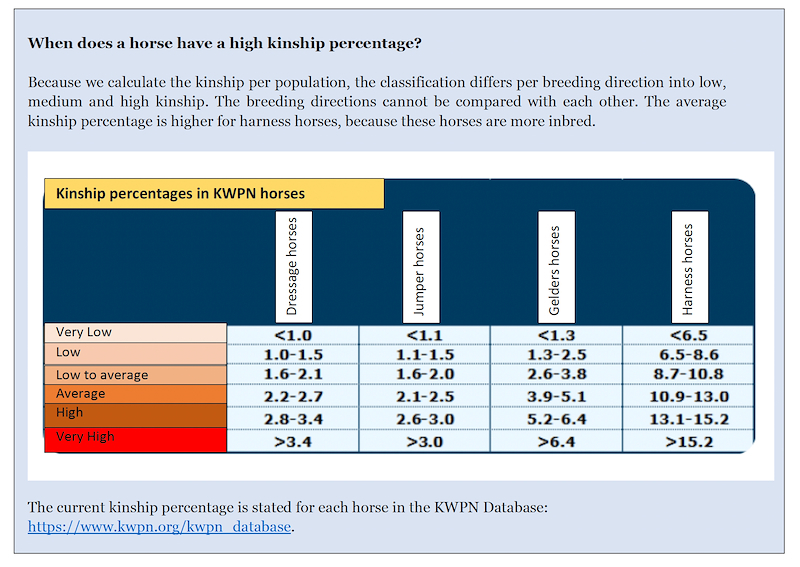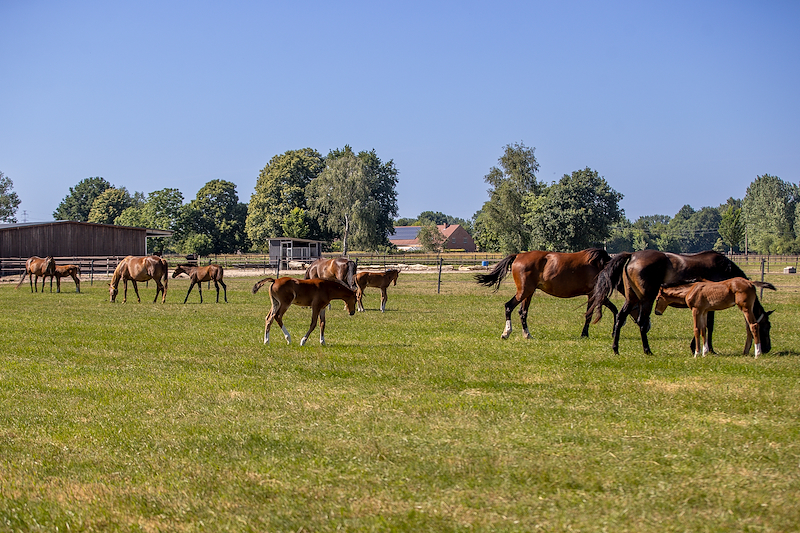Longread: In breeding or line breeding?
In smaller populations, the danger of inbreeding always lurks. An important point of attention for breeders. Sometimes breeders want to use line breeding to anchor the good qualities of their mare line. But is that a wise thing to do? And how does line breeding differ from inbreeding?
Let’s start with the technical details: genes are pieces of DNA that code for a hereditary trait; each gene consists of two so-called ‘alleles’. A foal receives one allele for each trait from the mother and one from the father. Inbreeding occurs when two related animals are crossed. The offspring then receives exactly the same genetic information from both sides for some of its characteristics, i.e. the same alleles. This is called 'homozygous'. If a horse has two different alleles for a particular gene, it is 'heterozygous' for that trait.
Kinship
The inbreeding percentage says something about an individual animal. Kinship, on the other hand, indicates the relationship between a horse and the population. For a harness horse we show the relationship percentage compared to the other harness horses and for a dressage horse compared to the other dressage horses. The kinship percentage of a horse is calculated relative to the youngest generations in the population (foals up to and including two-year-olds). This is because the DNA of the young animals contains all their ancestors. In addition, these young generations are the breeding stock of the near future and represent the most used stallions and mares of the moment. All kinship percentages are recalculated every year, relative to the most current population. When a young stallion is approved and starts breeding a lot, his kinship percentage will increase in the following years. After all, the stallion has more and more relatives, namely his sons and daughters.
Genetic diversity
Using the kinship percentage, we can see which animals are important for the population in the context of blood distribution, or genetic diversity. When genetic diversity is high, there are many different alleles for each genetic trait. A genetically diverse population is more resilient to, for example, diseases or changing circumstances. If genetic diversity decreases, there is a risk that you will encounter problems in the future that can no longer be solved. For many plant species there are therefore 'gene banks' with seeds from old varieties. If a disease develops in an important food crop in the future, those ancient plant seeds, with all their genetic diversity, could hold the key to the solution. By crossing with these ancient plants you can make a modern food crop healthy again. Genetic diversity is also very important in animals. When you cross an inbred horse with an unrelated animal, the offspring will not be inbred. Inbreeding is not hereditary; during such a mating, completely different alleles from the unrelated animal are added to form the genes of the foal. This way you safeguard genetic diversity for future generations.
Hereditary diseases
Inbreeding reduces genetic diversity and increases the risk of an ‘inbreeding depression’ and hereditary diseases. How does that work? Geneticist Rob Bergsma: “Every individual mammal has genetic defects in its DNA, which are recessive (non-dominant). The animal itself is not affected by this: as long as only one allele with this defect is present, nothing happens. However, if both parents are carriers of such a defective allele, an offspring can get two bad alleles and therefore inherit a defective gene. Such a horse is sick. This happened, for example, with WFFS. The more closely related parent animals are, the greater the risk that they have the same defective alleles. More inbreeding leads to more homozygosity. This means that if you cross related animals, the risk of disease increases.”
Inbreeding depression
Inbreeding depression is also a risk. If inbreeding within a population increases rapidly, the animals become weaker in general. Not only are more hereditary diseases emerging, fertility and life expectancy are also declining. By the time these kinds of problems become visible in your population, you are usually too late. Before genetic abnormalities due to inbreeding come to light, there must already be a lot of those 'bad' alleles in the population.
What is line breeding?
With line breeding, the breeder crosses family members with each other. For example, a Vivaldi mare is crossed with Jazz, her grandfather on her mother's side. With line breeding this happens several times in succession. For example, by crossing the daughter of the Vivaldi mare with the Jazz grandson Boston. The idea is that you 'capture' Jazz's fantastic dressage qualities in your breeding line. Not a strange thought. Because you keep throwing the same alleles into the mix, there is a chance that an animal will become homozygous for those traits. A mare will then always pass on the good 'sport alleles' to her offspring.
That sounds fantastic, but the problem with this is that at the same time – unconsciously – you also anchor the undesirable properties and diseases in such a line. In addition, new interesting genes do not get a chance, because you limit yourself to the genes that make Jazz interesting. Therefore, always think twice about line breeding. If you only want to breed a sport horse and not a breeding animal, then a slightly higher inbreeding does not have to be a problem. Although of course there is always the risk of an unhealthy foal or an animal that is less durable and fit. But if you want to breed an animal through line breeding, take that close relationship into account when choosing a stallion. Line breeding is just another word for inbreeding. Nothing more and nothing less.
Avoid high kinship
The KWPN strives not to increase the kinship within the population. When that does happen, it becomes increasingly difficult to avoid inbreeding in the future. The animals are then increasingly related to each other. The KWPN therefore wants the kinship percentage to stabilize, or preferably decrease. So, the risk of hereditary disorders and, for example, fertility problems will also decrease. Breeders in an open studbook such as the KWPN should be perfectly capable of curbing inbreeding. Sometimes this means they will have to make some compromises to keep the population healthy for the long term. Remember: breeding means thinking in generations.
Genotype can contribute
The inbreeding and kinship percentages are based on the pedigree, i.e. the data from the studbook. In this calculation method, full brothers and sisters are seen as identical, even though they may be very different from each other. In the future, we can determine relationships even more precisely, says Rob Bergsma: “When we have a genotype of most KWPN horses, we can look at the actual similarity in the DNA. Then you will sometimes see completely different things than you expected. The use of DNA also resolves any inaccuracies or gaps in older (foreign) studbook registrations. That will give direct results to work with.”]
Wise breeding decisions
You can calculate the inbreeding of a possible combination between a stallion and a mare with the inbreeding tool on the KWPN website. Together we must ensure that our horses remain healthy, and that the kinship of the population does not increase further. Rob Bergsma: “If inbreeding is too high, the tide eventually turns. At some point it becomes impossible to do something about it. Even if you don't get stuck now, you will in the next generation or the one after that. Breeders should anticipate on this. This sometimes means making a temporary concession. It also doesn't work if everyone uses the same closely related stallion, because then it becomes inbred again. Scientifically speaking, it is all quite manageable.”
“For some animal species, a breeding leader can determine the entire breeding policy. You can then manage it in such a way that each male animal makes an optimal contribution based on its genetics. The number of matings or inseminations by male animals then depends on both their breeding values and their kinship. Of course, you use animals with high breeding values, but if they are highly related, they are only used to a very limited extent. And animals with a low relatedness are also used, even if they have somewhat lower breeding values. This way, you still make progress in the population, but the relationship remains under control. But of course, it doesn't work that way with horse studbooks, where you deal with many small private breeders who all make their own breeding decisions. Breeding premiums, such as the one we give out to breeders of low-related harness horse foals, do provide a push in the right direction.”
Achievement versus kinship?
In the discussion about the use of low related breeding animals, one argument often surfaces: “Stallions that are low in kinship aren’t low for no reason. Less has been bred with that blood because those horses are less good.” There is some truth in that, but there could also be other reasons why certain animals have been bred less. And a horse with a genetic defect is not a good horse either. There are plenty of low-related horses that also perform well in sport and in terms of conformation. These horses in particular can be of great value. A well-performing and well- breeding low-related stallion also suits many mares and will therefore be able to cover a lot. Rob Bergsma: “Future prospects are also a reason to keep the kinship low: characteristics that we select for can change. Jumping courses are becoming more technical and in dressage, harmony and suppleness are becoming increasingly important. To be able to respond to ever-changing future demands, we desperately need to maintain genetic variation.”

Translation: KWPN-NA
Original author: Mirjam Hommes for KWPN – November 2022
Photo: Dirk Caremans























 KWPN Database
KWPN Database KWPN.tv
KWPN.tv KWPN Horses for Sale
KWPN Horses for Sale